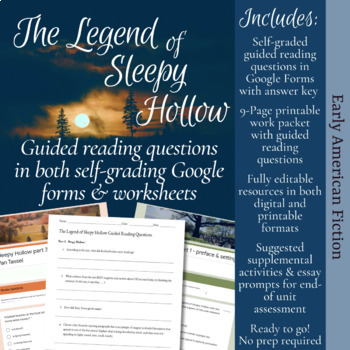The Legend of Sleepy Hollow questions in self-grading Google forms & worksheets
- PDF
What educators are saying
Description
The Legend of Sleepy Hollow is a fantastic short story to include in a Dark Romanticism unit or as a spooky Halloween lesson, but it takes some close reading and careful analysis for students to 'get' everything that is going on in the story.
These guided reading and analysis questions can help guide students through this complex, and very funny text. The questions are available in both self-grading Google Forms and printable worksheets and can be used for independent student reading, homework, sub-plans, e-learning, or flipped classrooms.
The full story can take from 1 to 2 weeks to complete, depending on how much time you have in class and which options you choose to incorporate.
Materials Include:
- Fully editable guided reading and analysis questions in both self-grading Google Forms and printable worksheets with answer keys
- MOST of the questions in the Google Forms are multiple-choice for quick & easy grading
- Character Analysis graphic organizer activity based on an online dating profile
- 10 different suggested essay prompts for end-of-unit assessment
- Pacing guide to help fit the materials into either a one-week or two-week unit, depending on if you have block or period scheduling
Everything is ready to go. Just print or post to your online classroom and you’re set. The materials are copied to your own Google drive, so you also have the option to edit or adapt them to suit your students’ needs if you choose to do so.
Goals for the lesson:
1. For students to be able to identify and analyze multiple meanings or interpretations in a text
2. For students to make inferences about the characters and action in the story, especially when the author chooses to be deliberately vague
3. For students to analyze the author's use of figurative language in a text
Literary terms covered:
Imagery
Characterization
Character motivation
Character foil
Character flaw
Hyperbole
Simile
Metaphor
Allusion
For a more comprehensive unit on Washington Irving and the Legend of Sleepy Hollow, see the bundle available here.
Other lessons which can supplement this resource are available in my Teachers Pay Teachers store here:
www.teacherspayteachers.com/Store/The-Little-Brown-Bird-Literature-Resources





